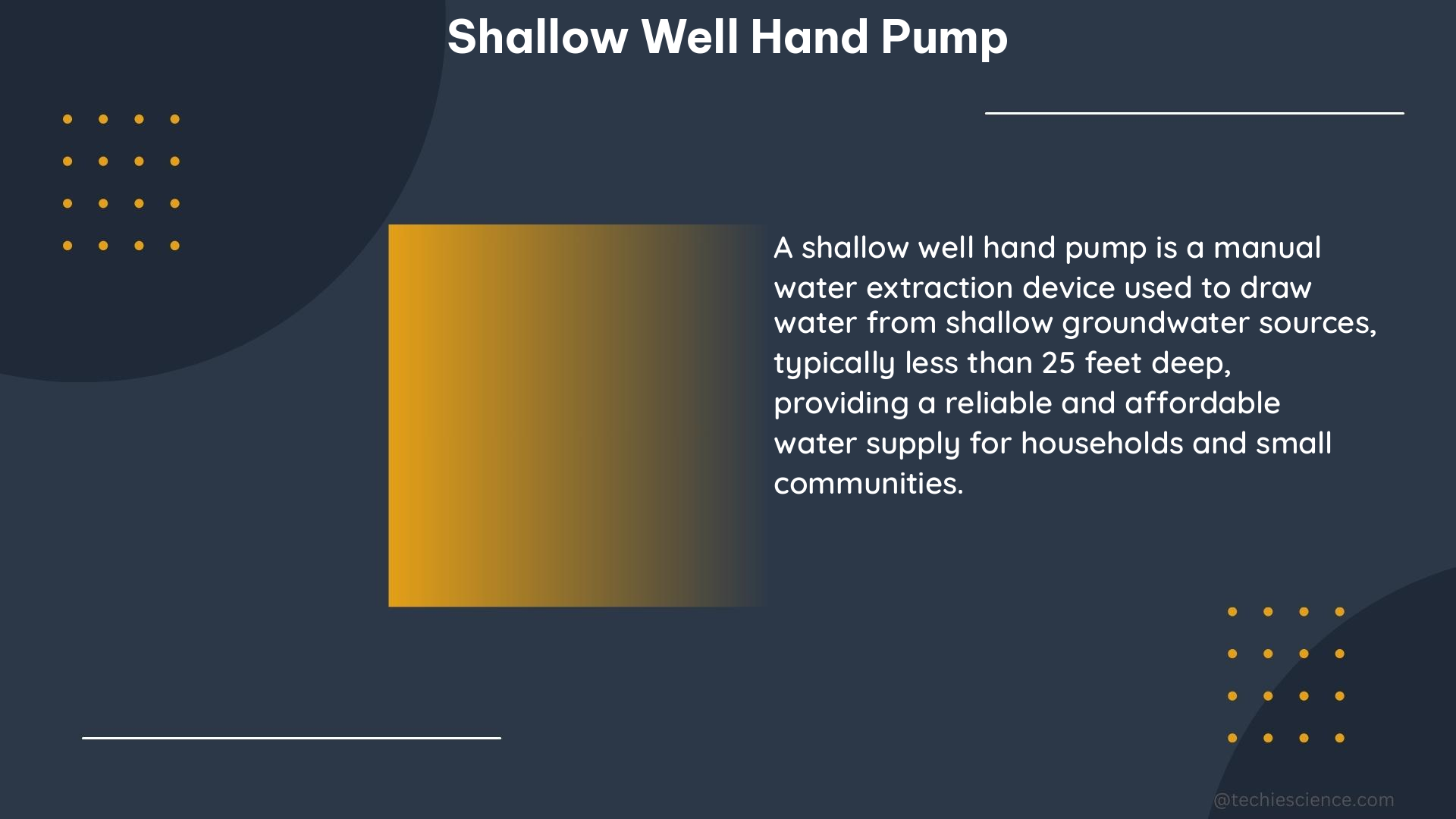Shallow well hand pumps are essential for accessing groundwater in many parts of the world, providing a reliable and cost-effective solution for communities with limited access to clean water. These pumps are designed to extract water from shallow aquifers, typically less than 25 meters (82 feet) deep, and are widely used in rural and peri-urban areas across the globe.
Yield Capacity: The Lifeblood of Shallow Well Hand Pumps
The yield capacity of a well is a critical factor in determining the suitability of a hand pump. A well with a high yield capacity can provide a significant amount of water, making it an ideal candidate for hand pump installation. According to a study conducted in Chitungwiza Municipality, Zimbabwe, the team selected wells with a yield capacity of at least 0.5 liters per second (L/s) for hand pump installation. This ensured that the selected wells could meet the water demand of the local community.
Drawdown and Recovery Rates: Balancing Water Supply

Drawdown and recovery rates are essential parameters for determining the performance of a hand pump. Drawdown refers to the decrease in the water level in a well due to pumping, while recovery rate is the rate at which the water level recovers after pumping. During a pumping test, water level measurements are taken at regular intervals to determine these rates.
For example, in a study conducted in Malawi, the researchers found that the average drawdown for shallow wells equipped with hand pumps was around 1.5 meters, with a recovery rate of 0.1 meters per minute. These values are crucial in ensuring that the hand pump can operate efficiently without depleting the water source.
Pumping Rate: Balancing Demand and Supply
The pumping rate is the rate at which water is pumped from the well, typically measured in liters per minute (L/min) or gallons per minute (GPM). The pumping rate depends on the yield capacity of the well and the capacity of the pump.
The Elephant Pump, a popular hand pump for shallow wells, has a pumping rate of around 10 liters per minute. This rate is sufficient to meet the daily water needs of a household, which is typically around 20-50 liters per person per day, according to the World Health Organization.
Static Water Level: Determining Pump Depth
The static water level is the level of the water table in a well when no pumping is taking place. This parameter is essential for determining the depth of the well and the length of the pump rod required. The static water level can be measured using a tape measure or a water level probe.
In a study conducted in rural Kenya, the researchers found that the static water level in shallow wells ranged from 3 to 15 meters, with an average of 8 meters. This information is crucial in selecting the appropriate hand pump and ensuring that it can reach the water table effectively.
Hand Pump Cost: Balancing Affordability and Accessibility
The cost of a hand pump is an essential factor in determining its affordability and accessibility. The cost of a hand pump can vary widely depending on the type, size, and materials used.
The Elephant Pump, a simple and low-cost hand pump, costs around $250 per unit. In comparison, more advanced hand pumps, such as the India Mark II, can cost upwards of $500. The choice of hand pump will depend on the available budget, the specific needs of the community, and the local market conditions.
Additional Considerations
Apart from the key parameters mentioned above, there are several other factors to consider when selecting and installing a shallow well hand pump:
- Pump Durability: The pump should be designed to withstand the wear and tear of frequent use, as well as environmental factors such as corrosion and UV exposure.
- Ease of Maintenance: The pump should be easy to maintain and repair, with readily available spare parts and a trained local workforce to provide support.
- Water Quality: The hand pump should be designed to prevent contamination of the water source, ensuring that the water is safe for drinking and other domestic uses.
- User Accessibility: The hand pump should be positioned in a convenient location, with easy access for all members of the community, including women and children.
- Community Engagement: The successful implementation of a shallow well hand pump project requires active community participation and ownership, ensuring long-term sustainability.
By considering these factors, along with the key parameters discussed earlier, communities can select and install shallow well hand pumps that meet their water needs effectively and sustainably.
Conclusion
Shallow well hand pumps are a vital component of water access and distribution in many parts of the world. By understanding the key parameters, such as yield capacity, drawdown and recovery rates, pumping rate, static water level, and hand pump cost, communities can make informed decisions and ensure the long-term success of their water infrastructure projects.
References:
- Inexpensive Well Water-Level Measurement – YouTube. https://www.youtube.com/watch?v=js-630N8WQI
- Guide to Conducting Pumping Tests – Gov.bc.ca. https://www2.gov.bc.ca/assets/gov/environment/air-land-water/water/water-wells/guide_to_conducting_pumping_tests.pdf
- Shallow aquifer monitoring using handpump vibration data. https://www.sciencedirect.com/science/article/pii/S2589915520300080
- Pilot Project ; Hand-pump installation for Shallow well. https://openjicareport.jica.go.jp/pdf/12125712_04.pdf
- World Health Organization. (2003). The right to water. https://www.who.int/water_sanitation_health/en/righttowater.pdf
- Shallow Well Hand Pump Performance in Rural Kenya. https://www.ncbi.nlm.nih.gov/pmc/articles/PMC6152831/
- India Mark II Hand Pump Specifications. https://www.ircwash.org/sites/default/files/Brikke-2000-Community.pdf

The lambdageeks.com Core SME Team is a group of experienced subject matter experts from diverse scientific and technical fields including Physics, Chemistry, Technology,Electronics & Electrical Engineering, Automotive, Mechanical Engineering. Our team collaborates to create high-quality, well-researched articles on a wide range of science and technology topics for the lambdageeks.com website.
All Our Senior SME are having more than 7 Years of experience in the respective fields . They are either Working Industry Professionals or assocaited With different Universities. Refer Our Authors Page to get to know About our Core SMEs.